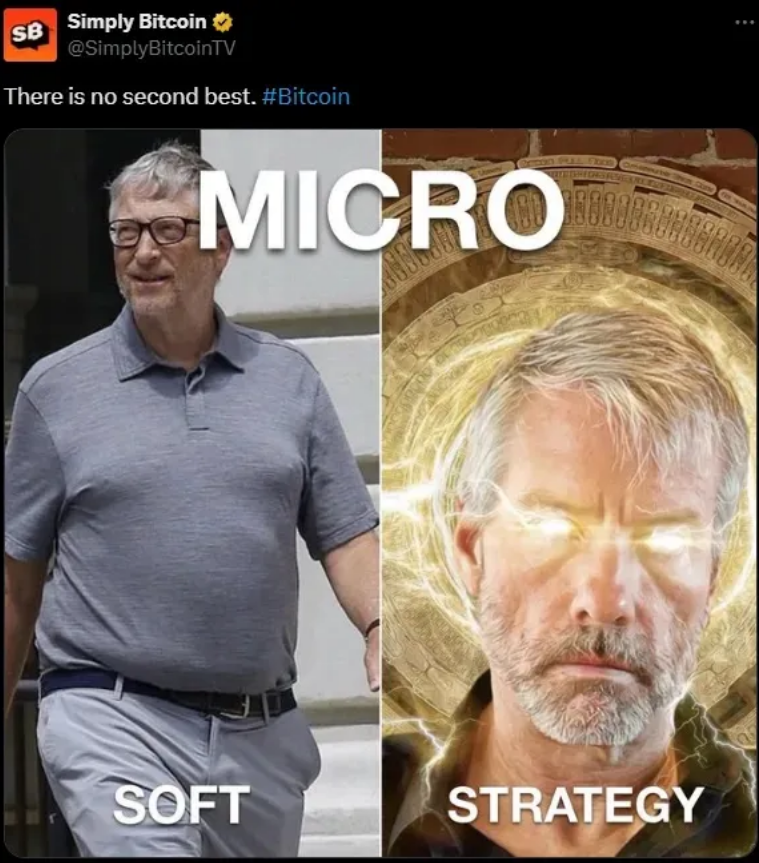Michael Saylor cleverly utilized the volatility of the stock market and the growth of Bitcoin by issuing zero-coupon convertible bonds to fund Bitcoin purchases, creating an innovative financial strategy.
Author: Sankalp Shangari
Translation: Blockchain in Plain Language

1. From Dull Bonds to a Stunning Comeback with Bitcoin
If you find traditional finance boring, you are not alone. However, cryptocurrency is different; it is destined to change the way financial markets and fiat systems operate.
Sometimes, there will always be a character who plays by their own rules, breaking conventions and bringing about new changes. Michael Saylor is such a person—he transformed a seemingly ordinary financial tool—convertible bonds—into a powerful Bitcoin acquisition machine. This can be seen as the "Ocean's Eleven" of the financial world, but instead of robbing a bank, Saylor combined market volatility, debt, and Bitcoin to successfully execute a "heist" on the entire market.
1) What are Convertible Bonds (and Why Should You Care)?
Convertible bonds sound as boring as a tax lecture, but they are actually very interesting tools in the financial realm. Imagine if bonds and stocks were combined; that’s what convertible bonds are. They are both a loan and have the characteristics of stock options. Companies raise funds by issuing these bonds, and investors buy them because they are flexible: you can hold them like bonds to earn stable interest, or if the stock price skyrockets, you can convert them into shares.
The key is that convertible bonds have a "conversion option," meaning they can be converted into company stock at a specific time in the future under certain conditions. This gives investors more choices and provides creative space for companies like MicroStrategy.
Four factors that affect the price of convertible bonds:
1) Interest Rates: If interest rates are high, bond prices are expensive.
2) Company Credit: The riskier the company, the higher the return demanded by bondholders.
3) Stock Prices: Since bonds can be converted into stocks, changes in stock prices are significant.
4) Volatility: The greater the stock volatility, the higher the value of the conversion option.
Among these, volatility is the most interesting part—and Michael Saylor's strategy is to seize this point, quickly capitalizing on the fluctuations like a roller coaster.
2) Saylor's Secret Weapon: The "Black Technology" of Convertible Bonds and How to Turn Volatility into Wealth
If convertible bonds are a hybrid car, then Saylor has found a way to turn it into an F1 race car. Here are four "simple" steps on how it works (of course, assuming you have been in the financial industry for 20 years):
A. Issue Zero-Coupon Convertible Bonds
Saylor's latest move is to persuade investors to lend him money at zero interest! How does he do it? He promises investors that they can convert the bonds into MicroStrategy stock in the future, and the conversion price is much higher than the current stock price. Investors find this "conversion option" particularly enticing and are willing to lend money at zero interest.
B. Earn Huge Premiums
The "conversion price" of these bonds is set significantly higher than the current stock price, sometimes by as much as 50%. This means investors must wait for the stock price to soar before they can convert the bonds into shares. This also gives Saylor a buffer period to avoid dilution of equity until the stock price skyrockets.
C. Get Cash to Buy Bitcoin
Saylor's core strategy is to use the cash obtained from selling bonds to purchase Bitcoin. In other words, he is exchanging debt for digital gold. This is not only a bet on the future of Bitcoin but also leverages stock price volatility to acquire more Bitcoin. If this sounds like a financial version of judo, it indeed is.
D. Achieve Long-Term Profits through "Value Dilution"
Typically, issuing more stock dilutes the shares of existing shareholders. But Saylor does it differently: by buying and holding Bitcoin, he increases MicroStrategy's net asset value (NAV) while also increasing the Bitcoin per share. It’s like buying a pizza and cutting it into more slices, but you end up with more pizza.
Here’s a concise breakdown of the "magic" steps:
Assuming MSTR's initial state:
Market Value = $1 million
Bitcoin Holdings = $300,000
Bitcoin to Stock Ratio = $300,000 / $1 million = 0.3
Stock Issuance:
MSTR issues an additional $2 million in stock, bringing the total market value to $3 million ($1 million + $2 million).
Use this $2 million to buy an equivalent value of Bitcoin.
New Bitcoin Holdings = $300,000 + $2 million = $2.3 million
New Bitcoin to Stock Ratio = $2.3 million / $3 million = 0.7667 (approximately 0.77).
This is the essence of "financial engineering." By issuing stock, increasing the company's market value, and then using those funds to buy more Bitcoin, MicroStrategy has increased the Bitcoin ratio per share without directly diluting existing shareholders' equity. This can enhance the attractiveness of the company's stock when Bitcoin prices rise.
This mechanism can continue to operate as long as the market is willing to give MSTR a premium based on its Bitcoin holdings. If market confidence declines, this premium may disappear (or even reverse), leading to a sharp drop in stock prices.
In simple terms, it’s like using "cheap paper" (stocks) to exchange for "hard currency" (Bitcoin). This strategy can work until the market no longer values this "paper."
"Magic, isn’t it?" Of course—but only if the market continues to cooperate.

Wait, who would buy these things? (Hint: Not Grandma)
You are right—this is a classic hedge fund operation. Let’s take a closer look at how these operations work to help those who are less familiar understand the principles behind them.
2. Who Would Buy These Zero-Coupon Convertible Bonds?
The answer is: hedge funds, not your grandma's retirement fund.
Why? Because hedge funds do not care about interest payments. What they are interested in is something more profitable: volatility.
These zero-coupon bonds (which do not pay interest) come with an additional stock purchase option (like MSTR stock). Hedge funds buy these bonds not to hold them long-term like traditional fixed-income investors, but to leverage stock market volatility using complex strategies like "delta hedging" and "gamma scalping."
Delta Hedging: Adjusting sensitivity to changes in stock prices. If MSTR's stock price rises by 10%, they need to adjust their positions to maintain a "neutral" state (for example, shorting/selling some stock to remain market neutral).
Gamma Scalping: Profiting from the speed of stock price fluctuations. When stock prices are volatile, gamma strategies can help them earn profits from these fluctuations, generating gains each time they adjust their hedges.
In simple terms, these hedge funds do not care about the "direction" of MSTR stock's price movement; they are more focused on the volatility of the stock price.
3. How Do Hedge Funds Make Money from These Bonds?
Buying Low: When Michael Saylor issues these convertible bonds, he usually "leaves some value on the table," meaning the initial price of the bonds is lower than their actual value (ensuring the bonds can be successfully issued). For example, if the "implied volatility" (IV) is set at 60 but the market later trades it at 70, the hedge fund makes 10 points (which is significant in the bond market).
Volatility Arbitrage: Hedge funds buy the bonds (going long on volatility) and then short MSTR stock to hedge. As MSTR's stock price fluctuates, they continuously adjust their positions, buying and selling stock as needed. The greater the volatility, the more adjustments they make, and the larger the potential profits. If implied volatility (IV) rises, the price of the bonds will also increase. Hedge funds can sell the bonds for quick profits.
First Day Gains: These bonds typically increase in price on the first day after issuance. This is because their initial pricing is low (to ensure market demand), and once the market realizes the "true" value of the bonds, they are repriced. Hedge funds can resell the bonds at a higher price in a short time, achieving quick returns.
4. Why Does Michael Saylor Do This?
The answer is simple: he needs cash to buy Bitcoin. By issuing convertible bonds, he can raise cash without issuing stock, thus avoiding shareholder dilution (at least for now). These bonds will only convert to stock when MSTR's stock price rises significantly. This means he can raise funds at a lower cost, and dilution of equity will only occur when the stock price rises.
Hedge funds are very fond of this operation. They buy convertible bonds at low prices, profiting from the initial pricing difference (essentially earning "free money"), and can also make money from stock market volatility. This is essentially a "win-win" situation for both hedge funds and MSTR (at least for now).
1) Why is This "Free Money"?
Hedge funds are essentially harvesting the "pricing errors" in the market.
They buy the bonds at low prices,
see the bond prices rise on the first day,
and then hedge against volatility with MSTR stock, making small profits each time the stock price fluctuates.
If MSTR's stock price skyrockets, they can still profit from the options in the bonds.
Hedge funds favor this operation because they can take on massive positions (hundreds of millions of dollars) with relatively low risk. For Saylor, this means raising billions of dollars without directly diluting shareholder equity. Everyone benefits from this… until the market no longer cooperates.
This is what is called "free money"—but only if you are a well-funded hedge fund with a Bloomberg terminal and a coffee addiction.
2) Is MicroStrategy a Bitcoin ETF? (Short answer: No)
Some critics argue that MicroStrategy is just a "luxury version of a Bitcoin ETF." But that’s like calling Batman "just another rich guy in a suit." While both ETFs and MicroStrategy give you exposure to Bitcoin, there is a significant difference: ETFs charge fees, while Saylor increases the amount of Bitcoin corresponding to your shares each year.
Why? Unlike ETFs that charge management fees, MicroStrategy's Bitcoin holdings grow with each convertible bond operation Saylor completes. So, if you hold MicroStrategy stock, you actually receive more Bitcoin shares each year. It’s like getting a free medium pizza that suddenly turns into a large, just because the manager is in a good mood.

3) Why is This Strategy Effective, and When Does the "Music Stop"?
Michael Saylor's strategy has great potential but also comes with significant risks. Let’s break it down step by step to see how he walks the tightrope and when he might face major challenges.
MSTR Balance Sheet - Debt to Bitcoin Ratio
Bitcoin Holdings: Approximately $45 billion
Convertible Debt: Approximately $7.5 billion
Other Debt (Interest-Bearing Debt): Approximately $2.5 billion (roughly interest debt)
Total Debt: Approximately $10 billion
Debt Maturity: About $1 billion in debt will mature in 2027-2028.
On paper, MicroStrategy's financial situation looks good, with their Bitcoin assets ($45 billion) exceeding their debt ($10 billion). But the hidden risk here is volatility risk.
Assuming Bitcoin's price drops by 80%, from the current $25,000 to $20,000, then MicroStrategy's $45 billion in Bitcoin would shrink to about $10 billion, making the $10 billion debt burden feel particularly heavy.
However, for Saylor to truly face a "margin call," Bitcoin's price would need to drop to around $20,000. If that happens, MicroStrategy would face a liquidity crisis, and Saylor would have to make some tough decisions.
What Happens if Bitcoin Drops 80%?
If Bitcoin crashes, the situation could deteriorate rapidly, mainly due to the feedback loop between convertible bonds, stock prices, and Bitcoin prices.
Stock Price Decline: MSTR stock is closely tied to Bitcoin prices. If Bitcoin drops, MSTR's stock will also plummet.
Convertible Bondholders' Options: At this point, bondholders have the right to demand cash instead of converting the bonds into stock (since the stock has no value compared to the debt's face value).
Forced Selling: If bondholders do not want stock, Saylor would have to sell Bitcoin to repay the debt.
Market Downward Spiral: If Saylor sells Bitcoin, it would further depress Bitcoin prices, leading to more selling and creating a vicious cycle.
This is akin to entering "margin call hell," where Saylor might have to sell Bitcoin at a loss to maintain the company's solvency.
Key Point: Saylor is essentially betting that Bitcoin will not fall below $20,000. If it does, he will enter "survival mode," and MicroStrategy may be forced to sell Bitcoin to repay debt.
How Does Saylor Mitigate Risk?
Saylor is clearly not a fool; he has established several "lifelines" just in case. Here are some strategies he has implemented:
MicroStrategy's Core Software Business
MicroStrategy continues to operate a profitable and cash-flow-stable software business.
This business generates enough cash to cover smaller debt interest payments (about $50 million annually) without needing to sell Bitcoin.
This acts as the company's "safety net," allowing it to operate without selling Bitcoin.
ATM (At-the-Market) Issuance
MicroStrategy quietly issues stock into the market through at-the-market sales.
This method can bring cash to the company while avoiding a large one-time stock sell-off.
"Soft Redemption" Option (Forced Bond Conversion)
If MicroStrategy's stock price reaches a certain level, Saylor can activate the "soft redemption" option.
This means he can force bondholders to convert their bonds into stock instead of demanding cash repayment.
In simple terms, he can convert debt into equity at his discretion.
Substantial Bitcoin Reserves
Currently, MicroStrategy holds about $45 billion in Bitcoin.
He has enough room to sell some Bitcoin without having to liquidate all holdings.
This option is a last resort, but it still provides the company with emergency buffer space.

5. Conclusion: The "Master of Exploits" in Finance
Whether you like him or hate him, Michael Saylor is playing a whole new game. He is not just holding Bitcoin; he has built a complete strategy around it. By using convertible bonds, he cleverly combines debt, equity, and volatility into a financial flywheel that is almost unstoppable.
Every Bitcoin acquired by MicroStrategy is, in a sense, a "profit" for the company. This shift in mindset may one day lead analysts to suddenly realize that MicroStrategy's true value far exceeds their expectations. If that happens, the company's stock price could soar.
Overall, Michael Saylor has found a way to play four-dimensional chess in a two-dimensional market. He issues zero-coupon bonds, uses the raised funds to buy Bitcoin, thereby increasing the Bitcoin holdings per share. While this strategy carries significant risks, if Bitcoin continues to rise, it could become one of the smartest moves in financial history.
More and more companies are beginning to think about how to combine debt, equity, and Bitcoin. As this strategy becomes more widespread, we may be witnessing the dawn of a new era in corporate finance.
So, the next time someone says convertible bonds are boring, tell them the story of Michael Saylor. Watch their eyes widen as they realize this is not just about bonds, but a revolution in redefining the entire financial rules.
Article link: https://www.hellobtc.com/kp/du/12/5590.html
Source: https://hashtalks.substack.com/p/how-michael-saylor-turned-convertible?utmsource=%2Finbox&utmmedium=reader2
免责声明:本文章仅代表作者个人观点,不代表本平台的立场和观点。本文章仅供信息分享,不构成对任何人的任何投资建议。用户与作者之间的任何争议,与本平台无关。如网页中刊载的文章或图片涉及侵权,请提供相关的权利证明和身份证明发送邮件到support@aicoin.com,本平台相关工作人员将会进行核查。




